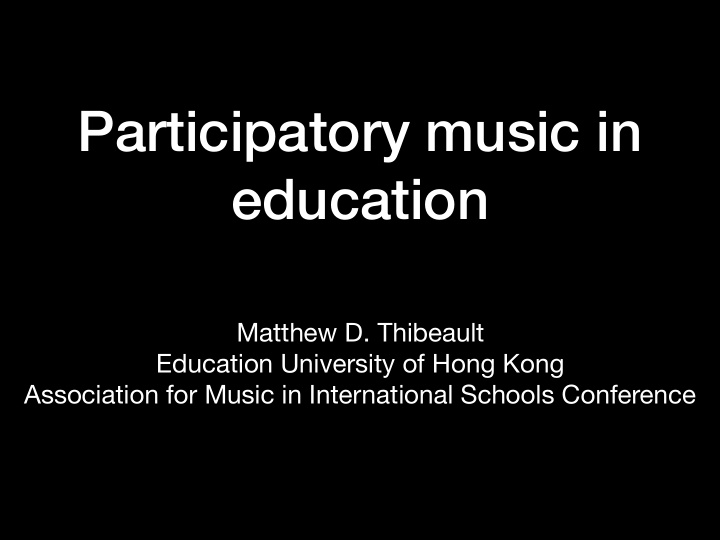



Participatory music in education Matthew D. Thibeault Education University of Hong Kong Association for Music in International Schools Conference
Let’s consider the dominant, ensemble-based, pathway of musical development we have achieved…
ballet & yoga
Specialist Model (and its drawbacks)
Goal is focused, dedicated, and sustained study
Ensembles achieve more specialisation and become more homogenous
What about everyone else?
Specialists vs. non- specialists Everyone else in school Successful music students
Specialists vs. non- specialists Everyone else in school “band geeks”
Musical development in this model is wonderful and efficient, but has a narrow direction. Leonhard critiqued programs’ “elitist virus” for its Eurocentrism. Leonhard, C. (1999). Grand Masters Series: A challenge for change in music education. Music Educators Journal, 86(3), 40–43.
Also, it’s a problem if you didn’t get on at the beginning Leonhard, C. (1999). Grand Masters Series: A challenge for change in music education. Music Educators Journal, 86(3), 40–43.
Fonder’s worry: “These academicians would have us abandon the 20 percent—the most motivated and interested students—to accommodate the other 80 percent.”
Leonhard’s solution: more stops to get on the train (ensemble), more kinds of trains
Nierman’s solution: classes for both the “talented few” and “not-so-talented many” See: Thibeault, M. D. (2015). Music education for all through participatory ensembles. Music Educators Journal, 102(2), 54–61. https://doi.org/10.1177/0027432115610170
“Music Appreciation”
If you’re not specialised, you don’t belong Everyone else in school “band geeks”
Another (my) answer: participatory models, based on societies and approaches with pervasive musical participation See: Thibeault, M. D. (2015). Music education for all through participatory ensembles. Music Educators Journal, 102(2), 54–61. https://doi.org/10.1177/0027432115610170
Turino’s distinction: Presentational/Participatory • Presentational: specialised, concerts for others • Participatory: music made with others • Turino studies Aymara of Peru, Shona of Zimbabwe, old-time musicians in the USA, etc. Turino, T. (2008). Music as social life: The politics of participation. Chicago, IL: University of Chicago Press.
Can you see which is participatory and which is presentational? Which is music for others, which is music with others?
Participatory photos: what comes to mind?
What sonic adjustments are made to have everyone participate?
Marching Illini
Fats Domino Memorial Second Line, New Orleans 2017
Participatory aspects: All are potential participants Simpler forms Many overlapping parts Dense textures (room for all) Wide intonation
Main di ff erence in structures
Okinawan sanshin beach BBQ; Toyama Japan
PS22 Choir, Staten Island (USA)
Choir!Choir!Choir! (Toronto, Canada)
Participatory and presentational values and concepts for education
Participatory can involve all, and exist alongside specialisation
Achievement vs. Togetherness
Presentational performance Sonically complex, socially simple
Participatory Performance Sonically simple, socially complex
Pedagogic opportunities • Include a few sing-along songs • Add some highly participatory (pop or not) repertoire • Teach a few songs on the fly • Bring some percussion to a performance (shakers, etc.) • Experiment with participatory structures, repertoire, values • Discover the local participatory repertoire • Think about abandoning precision, prestige, and power: come o ff the stage, turn o ff the amps, give up the microphones, and dissolve the borders between your group and everyone present.
Ballet vs Yoga: how does what each develops differ? How might this apply to music?
Recommend
More recommend